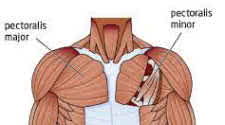Pec Minor Exercises - Workouts that Build Pectoralis Minor Muscle

Kinesiology Outlook for Muscular Fitness & Exercise
The next time you get the chance, take a good look at the upper chest of a competitive freestyle swimmer. What you'll see is upper-chest development that can rival that
of many bodybuilders. and the reason for this is the best kept secret in chest training, a secret that has been overlooked by many experts throughout the history of
pumping iron.
The secret is that you should train your pectoralis minor, and the reason that swimmers have such great upper-chest development is because the pee minor is responsible
for half of the freestyle stroke. Why haven't you heard about this secret muscle before? Simply because the pee minor isn't a glamour muscle like the much more popular
and well-known pectoralis major. Even so, the pec minor is as a big as the biceps. Since one of the goals of bodybuilding is to increase the size of your chest, it would
come in handy to develop a biceps-size muscle that lies under your pec major and that pushes out whatever is above it, wouldn't it?
Ask most bodybuilders about the best way to build a big chest, and the answer you'll get is that you should bomb and blitz your pec major. This attack usually calls for
more benches, inclines, flys and cable crossovers. To find the real answer, however, we have to rephrase the question, as follows: Do you want to increase the size of
your pectoralis major, or do you want to increase the size of the muscles that are on your upper rib cage and thereby enlarge what you call your chest?
When it comes to body-part training, in most cases the muscle that bodybuilders think they're working isn't the one that they're actually working. This is one reason that
so many bodybuilders waste half of their training time. Consequently, the first step in approaching the answer to the question is to identify the muscles that are actually
in the area that you want to train, and the second step is to determine how the muscle you want to train is affected by surrounding muscles.
The pectoralis minor runs from the coracoid process, a bone that extends forward from the scapula, or shoulder blade, on either side of your body down to the third, fourth
and fifth ribs. Obviously, it's not a small muscle by any means. The problem occurs when it's compared in size to the much larger pec major. The pec minor works when your
arm is extended straight up over your head. To illustrate this movement, stand and point one arm straight up in the air. Your elbow should be right next to your ear.
Now put the other hand up. Keeping your hands in this position, lie on a flat bench and have someone put a dumbbell into your hands. Notice that the dumbbell pulls your
arms back behind your head a Little. This is the beginning of the movement that trains the pecs minor, which is similar to a traditional dumbbell pullover except that your
elbows remain at your ears rather than sticking out to the sides.
The next step is to find the range of motion for this muscle, and the key to this is to understand that a muscle can only contract to around half its length. Remembering
what the pec minor looks like, begin to move the dumbbell upward. If you're doing the exercise right, you'll start to lose the pull after about six inches. This is the full
range of motion for this muscle, and as discussed above, it mimics the first six inches of the freestyle swimming stroke. When your elbows are inside the planes of your
shoulders, the pecs minor move your arms approximately six to eight inches, and even though you can bring the dumbbell over your head and all the way down to your waist, other
muscles take over after you get past that range.
Note also that during shoulder exercises or continual movement, the pecs minor function as stabilizers for the scapulae, not as prime movers. Proper form is essential on this
exercise, and to perform it correctly you have to remember that the pectoralis minor functions as a shoulder mover here, not an arm mover. Hold your elbows straight, keeping
them within the planes of your shoulders, throughout the set and emphasize the shoulder and arm on each side move along as a single unit upward. As soon as the elbows move
outside the planes of the shoulders, the lats take over.
As a side note, it follows that the reason why all the old-timers believed that dumbbell pullovers stretch the rib cage is because of the pec minor. Because it's attached to
three ribs, it's used indirectly in the traditional pullover and so they could feel it in their ribs when they performed that movement. The old idea was half right because you
cannot stretch your rib cage.
The fact that the human computer of the body can move through unbelievable ranges of movement in some cases causes bodybuilders to make assumptions that may not be true. This
is why it's important to define the exact range of motion for a particular muscle and a particular exercise before you plan your workout. Because the body works as a perfect
computer, it can pick up through various internal feedback systems when one muscle is overpowering another.
Consequently, if your body reads that your pecs minor are underdeveloped, it will slow down or even stop the development of the pecs major until the pecs minor catch up. The
feedback systems of the body work like this in order to protect you from developing serious imbalances. The next time you plan your chest routine, consider including an exercise
for the pec minor. This best kept secret for adding size to your chest might just be the missing ingredient that's keeping you from total chest development.